India’s clothing industry now influences 23% of global searches for sustainable textiles – a number reshaping how the world dresses. This seismic shift blends heritage with hyper-modernity, creating styles that honor tradition while rewriting style rulebooks.
We’re seeing craft communities collaborate with tech startups to reimagine classic silhouettes. Handloom saris get graphene-infused borders. Block-printed tunics incorporate temperature-regulating fabrics. It’s not just clothing – it’s cultural storytelling through thread and dye.
Three forces drive this transformation: eco-conscious millennials demanding transparency, artisans gaining direct market access through social commerce, and designers fusing regional embroidery with augmented reality fitting rooms. The result? Outfits that work equally well at Diwali gatherings and Parisian cafés.
Platforms like Instagram have turned local weavers into micro-influencers overnight. A single viral reel can sell out six months of Phulkari embroidery stock. This digital democratization lets consumers directly shape what thrives in 2025’s closets.
From zero-waste dyeing techniques to gender-fluid kurta designs, today’s trends reveal more than aesthetic preferences. They map India’s evolving identity – where centuries-old skills meet climate science, and personal style becomes planetary responsibility.
Unveiling the 2025 Fashion Evolution in India
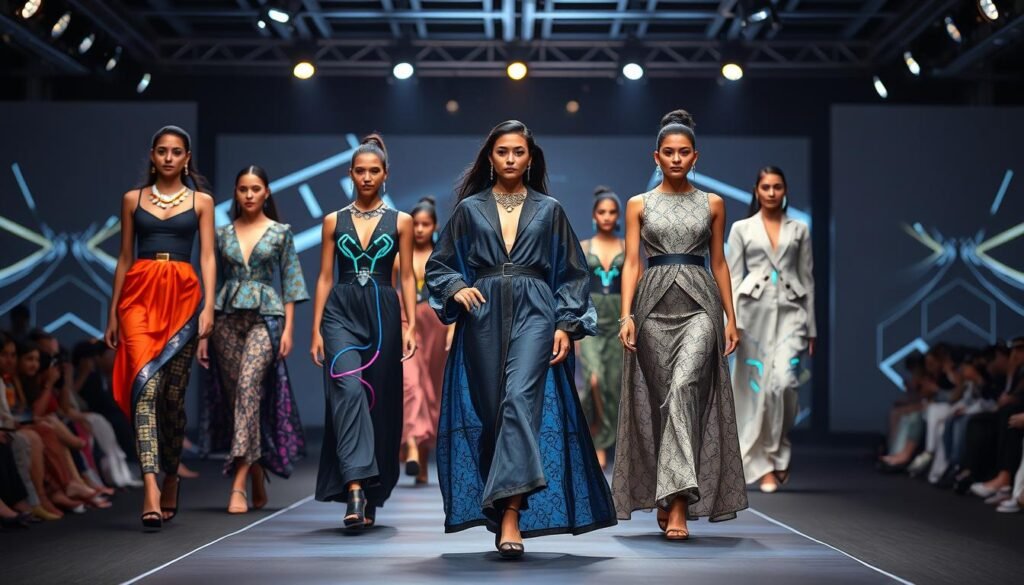
By 2025, a digital renaissance is transforming how traditional craftsmanship meets cutting-edge technology in apparel creation. We’re witnessing an unprecedented merger of handloom mastery with predictive algorithms – where heritage techniques inform machine learning models to create climate-responsive fabrics that adapt to regional weather patterns.
Setting the Context
The industry now operates like a three-loom shuttle: cultural preservation, technological adoption, and ecological responsibility interweave seamlessly. Designers collaborate with rural artisans through AR platforms, preserving embroidery patterns in digital libraries while updating them for modern tastes. This synergy creates collections that feel both timeless and avant-garde.
Industry Innovations Shaping the Future
Three breakthroughs redefine fashion design:
- AI-powered trend forecasting tools analyze social sentiment across 12 Indian languages
- Blockchain-tracked organic cotton supply chains ensure ethical sourcing
- 3D virtual showrooms reduce sample waste by 67% compared to traditional methods
Established brands and emerging labels now compete on equal footing through direct-to-consumer metaverse platforms. A Kochi-based startup recently launched ”Sari.Codes” – QR-enabled borders that unlock designer stories via smartphone scans. Such innovations prove India isn’t just following global movements – it’s rewriting the rules.
Sustainable Fabrics and Eco-Friendly Innovations

The fabric of Indian style is being rewoven with ecological consciousness at its core. We’re witnessing a tectonic shift where heritage textiles meet radical sustainability – transforming wardrobes into statements of environmental stewardship.
Organic Materials at the Forefront
Natural fibers now define modern silhouettes. Breathable khadi cottons and temperature-regulating bamboo silks dominate collections, offering 48% better moisture control than synthetic blends. Designers blend these fabrics with traditional weaving techniques, creating saris that decompose naturally without leaving microplastic traces.
Artisans in Rajasthan are reviving ancient dye vats using marigold flowers and pomegranate peels. These plant-based pigments produce vibrant hues while keeping rivers chemical-free. A Chennai-based label recently debuted turmeric-dipped kurtas that naturally repel mosquitoes – proving sustainability can enhance functionality.
Ethical and Upcycled Designs Changing the Game
Zero-waste patterns now dictate cutting room strategies. Mumbai studios transform sari scraps into structured blazers, while Delhi ateliers weave factory leftovers into bohemian jackets. One Surat manufacturer upcycles 12,000 plastic bottles daily into weather-resistant shawls – turning pollution into premium accessories.
Transparency drives consumer choices. Blockchain-tracked hemp skirts let buyers trace every growth stage, while QR-enabled tags reveal a garment’s carbon footprint. Our closets are becoming ecosystems where every thread tells an earth-conscious story.
Indo-Western Fusion: Bridging Tradition with Modernity
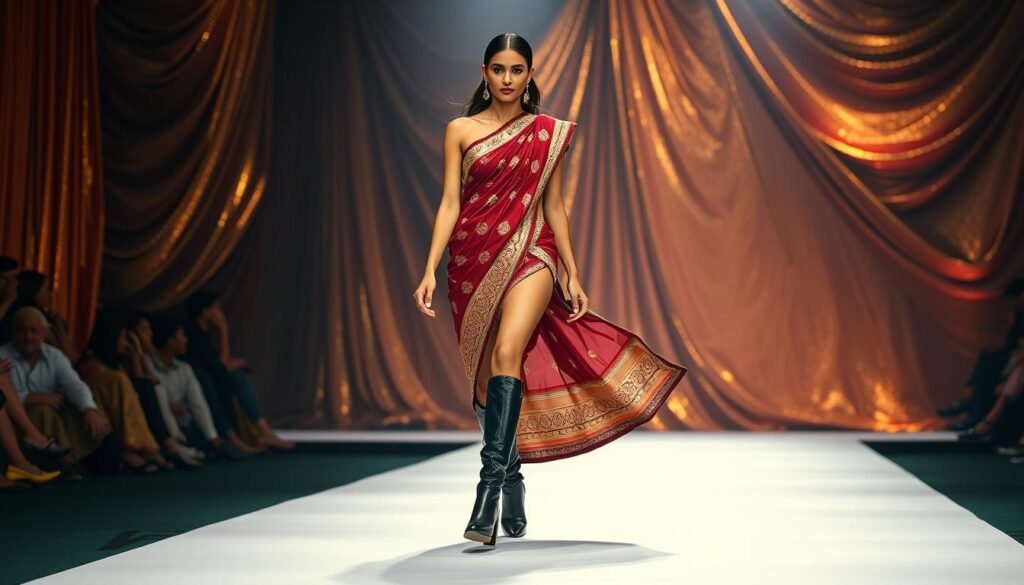
Cultural boundaries dissolve as contemporary wear becomes a canvas for heritage reinterpretation. We’re seeing a sartorial revolution where age-old craftsmanship converses with global aesthetics through deliberate design choices.
Mixing Cultural Elements Seamlessly
Traditional lehengas now pair with structured crop tops, their sharp angles contrasting with flowing skirts. Sarees gain unexpected edge when draped over turtlenecks or layered under moto jackets – a masterclass in balancing delicate embroidery with urban textures.
Designers reimagine sharara sets through asymmetrical cuts and geometric necklines. One Mumbai label recently debuted dhoti pants with detachable kimono sleeves, proving cultural fusion extends beyond Indo-Western binaries.
Key Designer Spotlight and Influencer Trends
Pioneers like Rahul Mishra blend chikankari with architectural draping, while Payal Khandwala merges Banarasi brocades with minimalist silhouettes. Their collections demonstrate how heritage techniques can feel strikingly modern.
Social media accelerates this movement. Gen-Z creators style bandhani dupattas with bucket hats, making traditional textiles relatable. A viral TikTok trend shows how to knot a saree over cargo pants – racking up 18M views in three days.
Accessories complete the fusion narrative. Temple jhumkas meet sleek crossbody bags, and kolhapuris get reworked with metallic finishes. These pairings prove cultural dialogue in fashion isn’t just possible – it’s inevitable.
Gender-Neutral Clothing: Style Beyond Boundaries
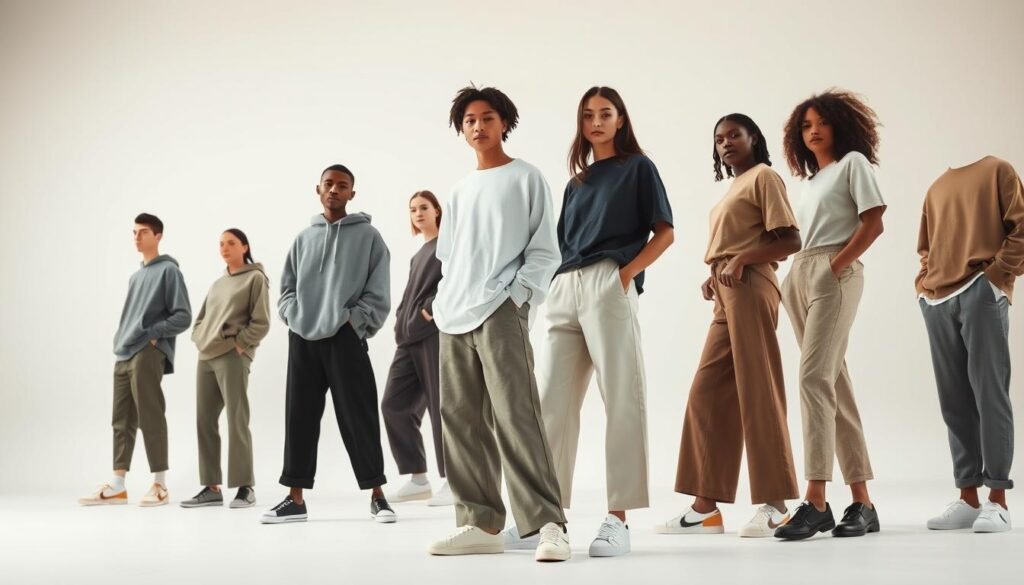
Fashion’s next frontier isn’t about seasons or silhouettes—it’s dismantling the binary code of dressing itself. We’re witnessing a cultural reset where clothing becomes a universal language, with 78% of urban millennials prioritizing versatility over gendered labels. Designers now craft pieces that adapt to diverse bodies and identities, rewriting style rulebooks stitch by stitch.
Inclusive Trends and Modern Silhouettes
The new wave of fashion champions architectural cuts that flatter without confinement. Think boxy kurtas with adjustable waist ties, or dhoti pants paired with structured blazers. These designs celebrate movement over measurement, using fluid fabrics that drape differently on every frame.
Streetwear’s influence accelerates this shift. Oversized band collars and drop-shoulder tunics dominate shared wardrobes, while monochrome palettes replace gender-coded hues. A Delhi-based collective recently launched modular sarees with detachable sleeves—proof that tradition evolves through inclusive reinvention.
Young consumers drive this transformation, treating styles as extensions of identity rather than societal checkboxes. Brands respond with unisex lookbooks featuring models of varying ages and body types. The message is clear: true innovation in dressing happens when we stop asking “who it’s for” and focus on “why it matters.”
Regional Weaves Making a Comeback
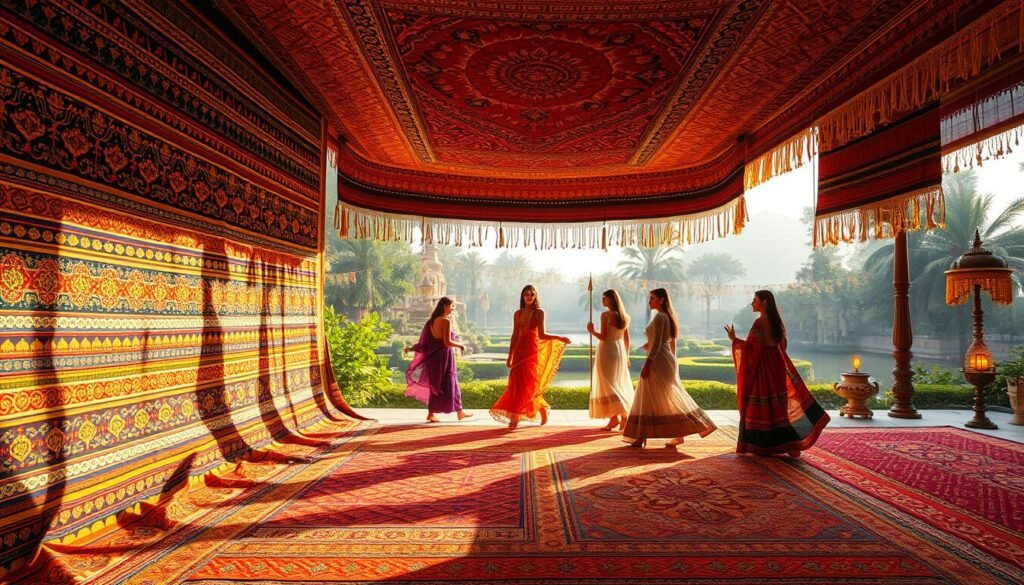
Ancient textile traditions are experiencing a vibrant resurgence, with heritage fabrics becoming the backbone of contemporary elegance. From Banarasi silk trench coats to Chanderi culottes, regional weaves now anchor capsule collections that honor craft lineages while speaking to modern sensibilities.
Reviving Traditional Textiles
Designers are reinterpreting time-honored techniques through fresh lenses. Ikat patterns transform into asymmetrical bomber jackets, while Pochampally’s geometric motifs grace minimalist slip dresses. These designs maintain cultural authenticity through original weaving methods but update proportions for today’s lifestyles.
Kanjeevaram saris get lightweight linings for office wear, proving heritage pieces can adapt. A Hyderabad studio recently debuted solar-powered looms that triple production without compromising handwoven quality – blending tradition with tech-driven scalability.
Local Artisans and Heritage Craftsmanship
Digital marketplaces now connect master weavers directly with global buyers. A Varanasi cooperative uses Instagram Reels to demonstrate six-hour border-weaving processes, creating educational content that drives 300% year-over-year sales growth.
Young consumers collect handloom fashion like art investments, valuing the 40-step creation process behind each Maheshwari saree. This revival extends beyond clothing – Mysore silk lampshades and Assamese muga silk tablet covers bring craft narratives into living spaces.
The movement proves cultural preservation and commercial success aren’t mutually exclusive. When artisans earn fair wages through direct partnerships, centuries-old techniques gain new relevance in our interconnected world.
Street Style, Celebrity Picks, and Instagram Buzz
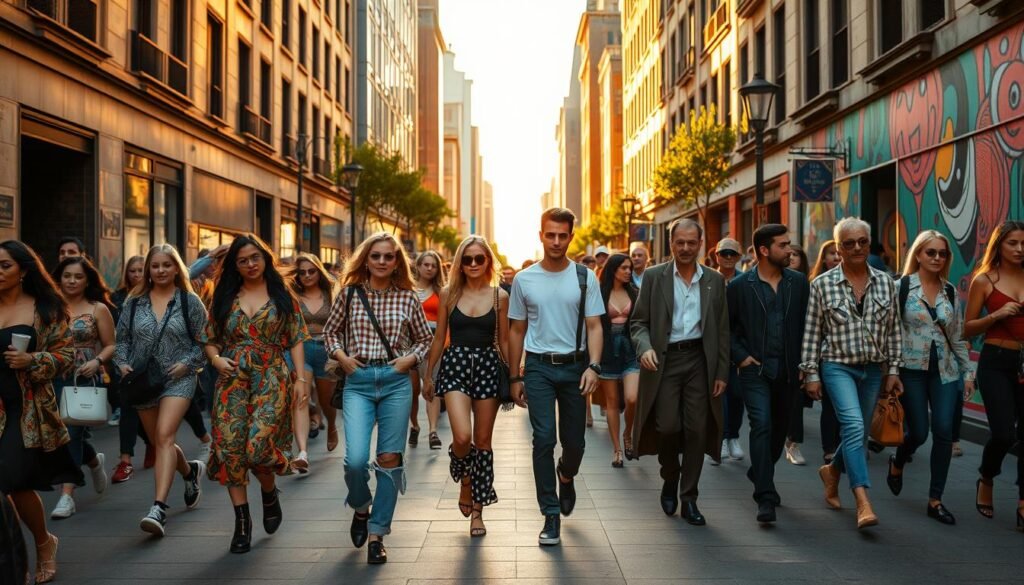
City sidewalks have become the new front row. We’re seeing style revolutions unfold where commuters strut and students accessorize – turning everyday spaces into dynamic fashion stages. Photographers cluster outside Mumbai’s CST station, capturing how streetwear blends with traditional textiles in unexpected ways.
Urban Runways and Trending Outfits
College campuses now incubate bold styling experiments. A Delhi student’s viral post shows cropped Nehru jackets layered over graphic tees – a look replicated across three states within 48 hours. These hybrid outfits mix heritage motifs with skate culture, proving innovation thrives beyond formal runways.
| Trend Source | Key Feature | Example |
|---|---|---|
| Street Style | Unexpected layering | Bandhani scarves with bomber jackets |
| Celebrity Influence | Accessible replicas | Deepika’s handloom saree + sneakers combo |
| Social Media | DIY tutorials | #DrapeItYourWay challenge (2.1M posts) |
Social Media and Influencer Impact
Platforms like Instagram transform how women discover trends. Micro-influencers demonstrate five ways to knot a dupatta using #ReelStyling hacks. A Chennai creator’s video on converting saris into cocktail dresses garnered 740K saves in a week.
Regional creators now drive 38% of fashion-related searches. Their content showcases Kochi’s kasavu saree street styles and Jaipur’s block-print shirt pairings – making local outfits globally desirable. When influencers tag artisan cooperatives, sales spike within hours, proving digital reach powers tangible change.
Innovative Designs With Bold Prints an
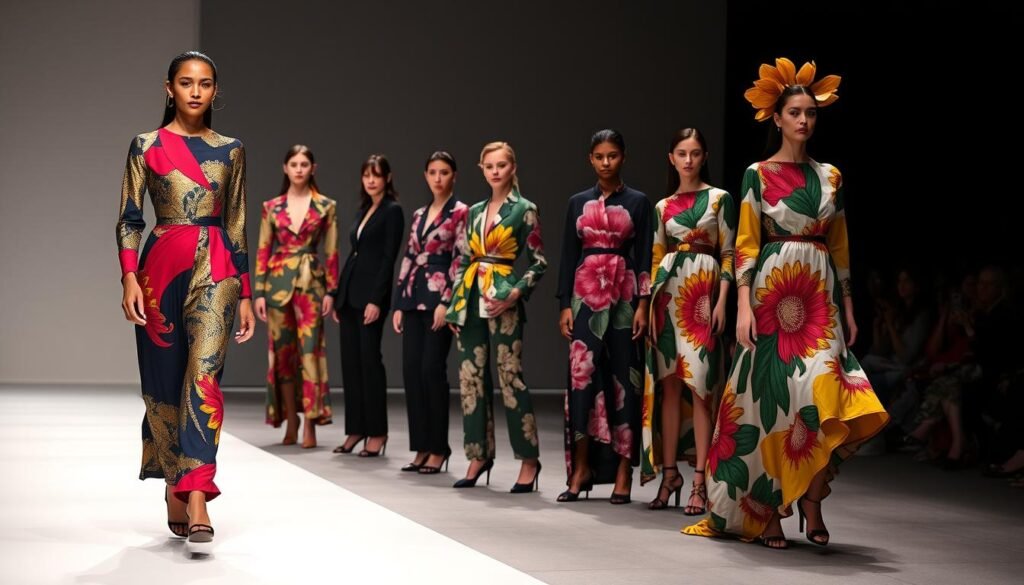
Patterns have become our cultural alphabet – a visual language rewriting style narratives through bold prints. Designers now treat motifs as dynamic code, blending ancestral symbols with algorithmic precision to create wearable storytelling.
AI-powered tools analyze temple carvings and folk art, generating fractal patterns that scale infinitely. A Jaipur studio recently debuted block-printed jumpsuits featuring AI-rendered mandalas that shift density based on body movement. These living patterns challenge static design traditions while honoring craft legacies.
Print innovation meets sustainability through waterless digital techniques. Solar-powered printers apply botanical dyes with micron-level accuracy, reducing water waste by 92% compared to screen printing. Chennai artisans now create QR-enabled motifs that reveal a garment’s creation journey when scanned – merging tech with transparency.
Youth-driven demand fuels experimental combinations. Warli art meets graffiti strokes on oversized shirts. Kalamkari dragons wind around contemporary trench coats. Each clash of eras in these innovative designs sparks new dialogues between past and future.
As prints evolve from decoration to declaration, they carry cultural codes into global contexts. What begins as a local pattern becomes universal language – proof that tradition thrives when reimagined through sustainable methods and fearless creativity.




